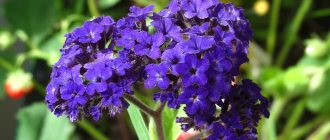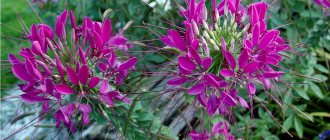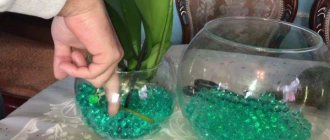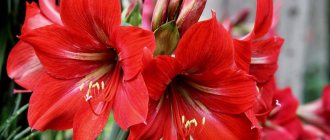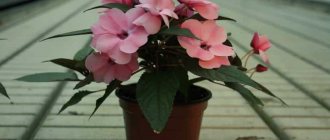Author: Elena N. https://floristics.info/ru/index.php?option=com_contact&view=contact&id=19 Category: Garden plants Published: January 06, 2019Last edits: January 20, 2021
- When to plant
- Growing conditions
- How and when to collect seeds
- Cleome Spinosa
flowers (lat. Cleome), or cleome , belong to the genus of annual or biennial plants of the Cleome family, growing throughout the globe in areas with warm and temperate climates and numbering about 70 species. For the peculiar shape of the inflorescences, the Germans call the cleome flower “spinenpflanze”, which means “spider plant”. Unusual brushes look like an explosion, a splash of champagne - you may not like this plant, but it is impossible not to pay attention to it. The spectacular beauty of the flowers, the strange smell, as well as the fact that the cleome plant blooms all summer from June to September - these qualities are increasingly attracting the attention of flower growers.
Planting and caring for cleome
- Planting: sowing seeds in the ground - before winter or in spring. Sowing seeds for seedlings - at the end of February, planting seedlings in the ground - at the end of May or early June.
- Flowering: from June to September.
- Lighting: bright sunlight.
- Soil: fertile, neutral reaction.
- Watering: only in extreme heat, but plentifully.
- Feeding: once every two weeks with complex mineral fertilizer. It is better to feed weak plants by leaves.
- Reproduction: seed.
- Pests: not damaged.
- Diseases: gray rot.
- Properties: the plant has an unpleasant, not at all floral odor.
Read more about growing cleome below.
Cleome propagation
The plant is propagated by the seedling method. For this purpose, freshly harvested seeds are used. Before planting in early March, they are placed in a growth activator solution for one day.
After this, they are planted in a container with a soil mixture of sand and peat, keeping a distance of four centimeters and removed to a warm place.
After the sprouts and the first leaves appear on them, the seedlings are distributed into individual pots, deepening them into the ground up to the grown leaves.
The sprouts are placed in the ground on the site at the end of spring, after the soil has warmed up and a stable positive temperature has been established, without significant changes.
The selected area must be protected from drafts, and it must also receive a sufficient amount of sunlight.
The soil on it must be carefully dug up, removing the roots of foreign plants. At the same time, you need to add fertilizers, both mineral and compost.
Planting is carried out at a distance of half a meter from one sprout to another. After this, the planted seedlings need to be watered, adding a little humate to the water.
In temperate climates where winters are relatively warm but snowy, it is possible to plant seeds directly into open soil.
It is produced in the last days of autumn, maintaining a distance between seeds of half a meter to a meter. The distance depends on the type, and, accordingly, the size of the future cleome bush.
The fallen snow will protect the seeds from freezing, and in the spring the first shoots will appear. In this case, flowering occurs a little later compared to using the seedling propagation method.
Botanical description
The root system of cleome is powerful, the strong stems are branched, covered with short glandular hairs and reach a height of one and a half meters. The leaves are light green, alternate, in some species covered below with small spines, simple or compound - with entire-edged linear elongated leaflets in the amount of five to seven; the apical leaves are entire and small. Regularly shaped flowers of white, purple, yellow or pink are collected at the tops in racemes; long stamens look like spider legs.
The fruit of cleome is a single-locular, pod-shaped polysperm, up to 3 cm long. Many lovers are puzzled by the not entirely floral aroma of cleome, but in the garden, in the fresh air, it is not noticeable at all, but it repels harmful insects. The fact is that this smell in cleome’s natural habitat areas attracts small bats that pollinate the plant.
Features of cleome
Cleome has a very powerful root system. Branched strong shoots, on their surface there is pubescence consisting of short glandular hairs. The height of the bush can reach up to 150 cm. The greenish alternate leaf plates of some species have small spines on the underside. Leaves can be simple or complex: they consist of 5 or 7 entire elongated linear leaflets. The apical leaf blades are small and entire. The apical racemose inflorescences consist of flowers that have a regular shape and are purple, pink, white or yellow in color. The flowers have relatively long stamens that look like spider legs. The fruit is a unilocular polysperm, pod-shaped, and can reach about 30 mm in length. Most amateur gardeners do not like the floral smell of cleome, but in an outdoor garden it is completely impossible to smell it, but it can repel pests. This unusual aroma is necessary for such a flower to attract small bats in the wild, which are its pollinators.
Flowers bloom beautifully for the garden. Cleome from seed to flowering!
Growing cleome from seeds
How to sow seeds
Cleome reproduces by seeds. How to grow cleome from seeds? They can be sown directly into the ground in the spring or before winter - in November-December, but it is best to use the seedling method of seed propagation. So, when to sow cleome for seedlings? Cleome has a long growing season, and if you want to collect ripened seeds in the fall, then you need to sow seedlings at the end of February. Before sowing, in order to speed up the process of germination, cleome seeds are soaked for 12 hours in a solution of Zircon or Epin (2 drops of the drug per glass of warm boiled water), then sown in a shallow container with seedling soil (garden mixture, humus and sand in a ratio of 2: 2:1), and sprinkled on top with a 1.5 cm thick layer of the same soil and covered with glass to create a greenhouse effect.
- Don’t throw away rotten potatoes – we’ll get elite tubers from them!
In the photo: How cleome blooms
Seedling care
Cleome does not germinate from seeds quickly, after 2-3 weeks, but after emergence, the seedlings are immediately transferred to a bright windowsill and provided with additional lighting in the evenings. Moistening is carried out as needed - not often, but abundantly, allowing the soil to dry out between waterings.
To prevent root diseases, seedlings are watered once with a weak solution of potassium permanganate.
When the seedlings have a pair of true leaves, they are planted in peat-humus pots, buried in the soil up to the cotyledon leaves. Two weeks after picking, you can feed the seedlings with complex mineral fertilizer in a weak consistency, and then apply fertilizer every two weeks. Rotate the pots from time to time relative to the light source so that the seedlings do not develop one-sided.
Reproduction and planting
When growing cleome, care should be taken to ensure a good sunny position and a permeable, light substrate.
Where to plant?
Cleome can be planted in different places in the garden. The real effect in a flower bed can be achieved by planting at least 6-10 seedlings nearby. Since cleome is impossible not to notice due to the large size and originality of the flowers, it can be planted as the background of a flower bed in the background.
The flower can be placed in the center of the flowerbed, but such a round or semicircular flowerbed is more suitable for large gardens, where a person can see the entire composition.
After mid-summer, the lower leaves begin to turn yellow and fall off, so you should not plant cleome too close to the front edge of the flowerbed - this not very pleasant feature must be hidden.
Cleome spinosa requires sunny or semi-shaded locations. In the shade it will stretch out unattractively; instead of straight stems densely strewn with flowers, we will get poorly flowering “stems.”
Despite its considerable size, cleome does not require supports.
What soils are needed?
Cleome blooms for a long time and actively develops; it needs fertile soil. Therefore, it is good to mix garden soil with compost soil before planting, adding as much rotted compost as possible. Organic fertilizer will provide the necessary substances for the proper development of the plant and improve the structure of the substrate, which will be more absorbent. It will absorb moisture better, retain nutrients longer, and will not be washed out too quickly during precipitation.
Before digging, it is also worth adding a dose of complete fertilizer.
In nature, cleomes grow on very permeable and not very moist soils (they have moisture in the air), so in heavy clay soils it is better to choose another plant.
So, to plant cleome you need soil:
- permeable,
- humus,
- easy,
- fertile,
- the humidity is moderate, cleome tolerates drought, but you should not plant it in too dry places.
Propagation by seeds
Cleome seedlings can be purchased as seedlings or sown and grown yourself. Cleome is propagated by seeds.
The seeds are relatively small, about 400 in 1 g.
When growing cleome from seeds, it is important to know when to plant the seeds in the ground or for seedlings. Seeds are planted at the following times:
- March-April (in the greenhouse);
- April (on the windowsill);
- May (in the ground in the southern regions).
Sowing seeds and growing seedlings:
- After soaking the seeds in water for 24 hours, they can be sown.
- Pour fertile soil into the boxes and carefully level the surface.
- The seeds should only be pressed down, not covered with soil, and moistened evenly with a spray bottle until germination.
- At a temperature of 18 °C, germination takes about 10-20 days.
- In April-May (2-3 weeks after emergence), seedlings are planted in pots with a diameter of 7-12 cm and grown at 15 °C. You can use yogurt cups for picking. The transplanted seedlings are placed on a light windowsill and watered.
- Before planting cleome in open ground, seedlings should be hardened off, but quite carefully, due to the high sensitivity of young plants to too low temperatures. To do this, they are taken out into the yard or onto the balcony, first for 1 hour, then the hardening time is gradually increased.
Cleome dissipates on its own if you do not pick off the faded flowers and allow the seeds to fall out by self-sowing. In spring, seedlings will appear in different places; they need to be thinned out so that they do not grow too densely. They need a lot of space, then they will grow beautiful, branch and have many flowers.
Propagation by cuttings
Cleome can be propagated by cuttings collected in September and planted in light soil. The cuttings are grown warm all winter and then planted in the ground the following spring. This method of propagating cleome is used quite rarely.
Planting in open ground, pots
Cleome seedlings are planted in open ground in May, when the danger of frost has passed. Only in the warmest regions can seeds be sown in the ground in April (in case of frost, it is worth covering the sowing site, for example, with agrofibre).
Before planting, we dig up the area, select weeds, and apply fertilizer. Plants are planted in holes.
According to the height of the plants, depending on the variety, the recommended interval between seedlings may vary. The lower the grade, the smaller the interval.
Scheme for planting cleome in the ground:
- medium-sized varieties - 30-45 cm;
- high varieties - 50-70 cm;
- low – about 30 cm.
After planting, water the plant more often.
When planting cleome in pots, plant in light, permeable soil a maximum of 2 pieces per pot with a diameter of 30 cm or 1 plant when forming a composition with other species.
Advice. To make plants branch strongly, they can be pinched, but this will delay flowering.
Planting cleome
When to plant
When the return frosts pass, the seedlings can be planted in the ground. Usually the time for planting occurs at the end of May or beginning of June. Select a sunny area without strong drafts for cleome seedlings, and they don’t need anything else, although cleome grows better on fertile soil of a neutral reaction, with good moisture, than on poor dry soil. Therefore, if the soil in the area for cleome leaves much to be desired, add a bucket of rotted compost and two tablespoons of granular flower fertilizer per square meter when digging.
In the photo: Growing cleome in the garden
How to plant
Before planting seedlings, for better rooting in open ground, spray the seedlings with a solution of the Epin-Extra stimulant with cytovit microfertilizer, as indicated in the instructions. Planting cleome in open ground is carried out with peat-humus pots at a distance of 50 to 70 cm between specimens. This is done so that the planting does not thicken, the plants are not affected by pests and diseases, and the flowering is abundant and bright. After planting, water the cleome under the root with a solution of humate.
How to plant hydrangea - practical advice
- Blackleg - 4 conditions, the fulfillment of which will help you forget about this disease on seedlings forever
Cleome – photo
The bizarre inflorescences of cleome look original both up close and from a distance. It’s easy to look at them for at least an hour and never find anything similar!
Photo: 2sotki.ru Photo: sdelai-lestnicu.ru
Photo: oir.mobi
Photo: thefunbank.blogspot.com
Photo: youscreen.ru
Photo: shop.rassadacvetov.com Photo: flowerpowerdaily.com Photo: botanichka.ru
Photo: avto.goodfon.ru
Photo: liveinternet.ru
Photo: distano.ru
Photo: domashniecvety.ru
Photo: fotoload.ru
Photo: sady-msk.ru
Photo: pxhere.com
Photo: gardeningjules.com
Photo: chudogryadka.ru Photo: botanichka.ru
Photo: grounde.ru
Photo: jooinn.com Photo: vlakar.ru
Photo: profermerov.ru
Photo: profermerov.ru Photo: 2sotki.ru
Photo: extension.msstate.edu
Photo: na-dache.pro
Did you like the post? Subscribe to our channel in Yandex.Zen, it really helps us in our development!
Cleome care
Growing conditions
Caring for cleome is simple: water only in hot weather, infrequently, but generously, feed once every two weeks at the roots with complex fertilizers such as Fertika-lux or Fertika-combi, diluting two tablespoons of fertilizer in 10 liters of water. A weak and diseased cleome bush should be fed leaf by leaf by spraying with a solution of one teaspoon of fertilizer in three liters of water. If you can’t wait to see cleome bloom, spray it with Zircon solution before the formation of buds at the rate of 1 ml of the drug per 1 liter of water.
In addition to these manipulations, growing cleome involves removing weeds and loosening the soil if you are too lazy to mulch it after planting.
In the photo: Unblown cleome inflorescence
Pests and diseases
Due to the aroma of cleome, which is far from floral, insect pests do not approach the plant. And it gets sick very rarely, only if you did not plant it close to groundwater and did not water it without any measure, but since this is unlikely to happen, we can assume that cleome is invulnerable.
Dangerous diseases and pests
The unusual aroma of cleome effectively protects the flower from pests. The disease can result from errors in care and watering, high soil moisture in the location of the flower bed.
Damage to the root system
Of the pests, the most dangerous is aphids, which can lead to the death of plants. The description of the signs is as follows:
- formation of a sticky layer on the leaves;
- unsightly yellow spots;
- curling the edges.
Interesting! To get rid of pests, it is necessary to attract ladybugs and lacewings. They feed on insects and will quickly rid the area of their presence.
The disease can be eliminated with the help of special preparations or a solution of ordinary laundry soap. The following signs indicate root rot that has appeared on the shoots:
- wilting of the plant;
- the appearance of brown spots on the leaves;
- slow growth.
If the problem is too serious, you will have to completely tear out the plants in the affected area, and then treat the ground with special chemicals.
Cleome after flowering
How and when to collect seeds
Since the cultivation of cleome flowers is carried out exclusively by seeds, it is advisable in the fall, when they ripen, to collect the seeds for sowing before winter or in the spring. You can determine the degree of maturity of the seeds by eye: they are round, up to 1.5 mm in diameter, yellow or brown, depending on the color of the flowers. In order not to miss the moment when the pod bursts and the seeds spill onto the ground, it is better to place several pods in gauze bags, and then the seeds will fall not on the ground, but in them.
In the photo: white cleome
Cleome in winter
Cleome is an annual plant in our climate, so after frost it must be disposed of. In November or December, you can sow the seeds you collected in the fall into the soil to a depth of 1.5 cm and cover the crops with spruce branches, which you will remove with the arrival of spring, so that the seeds that have overwintered in the soil can begin to grow.
Growing in open ground
Cleome can be grown in any soil, the main thing is that the plant receives the required amount of fertilizer from additional fertilizing. For planting, you need to choose a bright and sheltered place from the wind.
Planting flower seedlings splashing champagne
Young plants are planted in small holes. It is necessary to leave a distance of at least 50 centimeters between plants. Bushes planted at such a distance will produce lush and powerful plants. This distance will help make caring for the bushes easier and reduce the likelihood of disease and pest damage.
The soil around the seedlings is compacted and watered; this is an important condition.
Caring for a flower splash of champagne
Caring for a plant in open ground:
- Watering. It is recommended to water with warm, settled water. Rainwater can be used. It is better to leave this plant without water than to water it too often. Cleome simply cannot tolerate stagnant moisture.
- Fertilizer. 2 weeks after planting seedlings in open ground, they are fertilized with complex compounds. For fertilizer, you can use complex compounds for garden plants. Repeated feeding should be done before budding begins. A sick or weakened plant should be sprayed with a weaker concentration of fertilizer.
- Loosening. The ideal option would be to loosen after each watering. During the process of moistening, the soil becomes dense and too heavy, and air does not reach the roots. Loosening makes the soil light and air flows properly to the roots. This plant grows much faster and develops better.
- Removing weeds. Weeds especially need to be removed around young plants. Fast-growing weeds will simply fill the surface of the soil and destroy the sprouts.
Types and varieties
Only two types of plants have been introduced into culture so far - Hassler's cleome (Cleome Hassleriana) and prickly cleome (Cleome Spinosa) . These two tropical South American species are very similar, differing only in the color of the flowers, so among gardeners, for convenience, it is customary to call both species Cleoma spiny.
Cleome Spinosa
These species are also used to create new varieties and hybrids by crossing. We offer you an introduction to the most popular varieties of cleome prickly:
- Sparaxis: cultivation and care in open ground
In the photo: Cleome Hassleriana
- Hellen Campbell – white cleome;
- Rosakenigin – pale pink cleome;
- Pink Queen and Rose Queen are also varieties with pink flowers;
- Golden Sparkler is a dwarf variety with yellow flowers;
- Giant Pink Cusen - large dark pink flowers;
- Sparkler Lavender - light purple inflorescences;
- Violet Queen is a cleome with inky purple inflorescences.
The most popular variety is the prickly cleome Cherry Queen, up to 60 cm high, with fragrant flowers 2-3 cm in diameter, of an original shape, on long stalks.
In the photo: Cleome Spinosa
Cleome Hassleriana
As for Hassler's cleome, the Champagne Splash variety, bred on the basis of this species, is grown in culture. The height of the variety is 120 cm, white or pink flowers with a diameter of 3-4 cm are collected in an inflorescence-brush up to 20 cm in diameter. Blooms from July until frost.
Cleome is used as a solo plant and in groups with annuals such as lavatera or fragrant tobacco. Due to its high growth, cleome is often grown as the background of a flower garden or hedge.
Description of the plant
Cleome or cleome (Cleome L.) is a genus of herbaceous or woody perennials and annuals of the Cleome family. In countries with warm climates it is grown as a perennial. The Latin name of the species Cleome spinosa is associated with the spiny base of the leaves. The plant has been known for a long time, but was not very popular. Now it is returning to gardens with new varieties. This is a plant with a rather exotic appearance.
The spider flower, cleome, gets its English name from its unusual-looking flowers with long stamens.
Botanical description:
- Annuals and biennials, perennials, sometimes woody at the base, and even shrubs.
- The shoots are erect, very strong, rigid, up to 1.5-2 m high, slightly branched or branched. The shoots are smooth or pubescent.
- The leaves are twisted, usually 3, 5 or 7 leaflets, rarely up to 11. They are located on a short or long petiole. The leaves along the entire length of the stem are large, with a prickly base, have a slightly unpleasant odor, and in appearance resemble hemp leaves. The leaf root is prickly, with 2 sharp spines growing at the base. Therefore, when caring for cleome you need to use gloves!
- The flowers are fragrant, collected in clusters of inflorescences, sometimes growing from the axils of the upper leaves. The clusters are elongated or flattened at the top. They have 4 sepals, usually fused at the base, persistent or falling off after flowering. 4 petals, uneven, tapering at the base, red, pink, yellow or white. There are 6 stamens, less often 4-12, they are longer than the petals and curved, similar to the legs of a spider. The cleome flower exudes a strong musky scent. The color of the flowers is white, pink, bluish-violet, purple or carmine.
- Fruit - single-celled multi-seeded capsules, often 10 cm long and about 4-5 mm wide. During fruiting, the inflorescence lengthens. Each pod contains about 20 light brown seeds. The seeds resemble snail shells.
- Root. Despite the fact that cleome is an annual herbaceous plant, it produces a rather deep tap root, so it does not like to be transplanted.
The entire inflorescence has some distinctive feature. The flowers in it are groups with alternating fertilized or sterile, and can be sterile either male or female. The inflorescence is very long and there are always flowers at the top, and at the bottom, after the fruiting flowers, seed pods appear.
The flowering period of cleome is from July to late autumn.
Caring for cleome seedlings at home
As mentioned above, cleome seeds at home take a long time to germinate, about 2-2.5 weeks. And this is only subject to proper sowing, care and optimal conditions! Therefore, it is very important to properly and promptly care for cleome seedlings at all stages:
- Be sure to ventilate the mini-greenhouse every day, removing the lid or film for 20-25 minutes. It is recommended to remove condensation from the surface of the covering material to avoid excess moisture. When the seeds germinate, you need to remove the cover.
- Remember to maintain the correct temperature. Immediately after planting, you need to place the container in a warm room with a temperature of about +23-26°C. After seed germination, you need to lower the temperature to 20 degrees during the day and about 18 at night.
- Full lighting is required, at least 12 hours. If there is a lack of light, the seedlings should be supplemented with light.
- You need to water regularly as the top layer of soil dries out. But be careful not to overwater the plants and allow the water to stagnate. Excess moisture will provoke the development of mold, fungal diseases, root rot, and the most dangerous black leg.
- To prevent fungal diseases, in particular blackleg, it is recommended to water the plants with a biofungicide solution (for example, Fitosporin, Gamair, Planriz, Alirin) approximately once every 2 weeks.
- 7 days after picking, you can feed the seedlings. Complex fertilizers for seedlings are suitable. A week before planting in open ground, you can repeat feeding.
Timing for planting cleome seedlings at home
When is the best time to plant cleome seedlings? It is optimal to sow at home in the first half of March . At the same time, the region in which you live has a great influence on the choice of timing. For example, in the southern regions it is possible to plant at the end of February, in the Moscow region - in the first ten days of March, in Siberia and the Urals - in mid-March.
How to plant cleome seedlings correctly: rules and diagram
Cleome can be safely called a plant exotic for our gardens. Although it has many fans who plant it every year, it is still not a very popular flower crop. Therefore, many summer residents have many questions: how to properly plant cleome seedlings, how to prepare for the procedure, what subtleties and tricks there are. Let's understand these issues with step-by-step instructions.
Step 1: Select landing packaging
To grow cleome seedlings, you can choose any container: a common box, a bowl, plastic or peat tablets, plastic cassettes, peat tablets. Containers must have drainage holes (except for peat products).
However, it is more convenient to simply sow in a wide, common, not very high bowl. The width of the container depends on the number of seeds, but the optimal height is about 6-8 centimeters. And then, when the seedlings grow up, you should plant them in separate cups.
If you don’t want to pick, you can immediately sow the seeds in individual cups or pots. It is recommended to plant 2-3 seeds in one container at once to protect yourself in case some seeds do not germinate. Then you should leave the strongest seedling.
Step 2: Prepare the soil
As with almost any other flower seedlings, cleome prefers a light, loose, nutritious substrate. The most common universal soil mixture for flower seedlings will do. You can buy it in almost any country-themed stores.
You can prepare the soil yourself. To do this, mix the following components thoroughly: garden soil or peat (2 parts) + sand (1 part) + compost or humus (1 part).
Advice! It is recommended to disinfect the soil for seedlings before planting. Disinfection will eliminate pathogens, molds and other pathogenic microorganisms. You can heat the soil in the oven and hold it over steam. After this, it is recommended to spill the soil with a solution of a biological fungicide, for example, Fitosporin.
Step 3: Prepare the seeds
Clem seeds can be characterized as slow-germinating. They take a long time, slowly and poorly to germinate. Therefore, treating cleome seeds before sowing seedlings is the most important stage in preparation for the procedure!
The simplest and most effective way to improve germination is to soak the seeds in a special growth stimulator . For example, the drug Zircon, Epin or Energen. It is necessary to prepare the solution and carry out soaking according to the instructions indicated on the package.
Immediately after pre-sowing treatment, you need to plant the seeds!
Step 4: Sowing cleome seeds
The final stage of this event is the direct planting of cleome seeds for seedlings. The sowing scheme consists of the following steps:
- Place a drainage layer of about 1.5 centimeters on the bottom of the container; perlite or brick chips will do.
- Fill the container with soil mixture, but leave a small distance to the edges of the container (about 2 cm).
- It is recommended to sprinkle a thin layer of wood ash on top of the ground; it will help minimize the development of fungal diseases.
- On the surface of the earth, make grooves 1 cm deep at a distance of 5 cm.
- Place the seeds in a furrow 3 cm apart.
- Fill the grooves with a 1 cm layer of soil, that is, so that the grooves are equal to the general level of soil in the container.
- Moisten the soil generously with a sprayer using clean, warm water.
- Cover the container with film, lid or glass to create greenhouse conditions (high humidity and heat). A mini-greenhouse is necessary for successful seed germination.
Combination with other plants in a flower bed or garden
When decorating a flower garden, a tropical guest can take its rightful place in the background or in the center. Its large cloud inflorescences perfectly complement the green landscape and combine with shrubs and trees.
Europeans saw the beauty of this original shrub quite a long time ago and began to use it to decorate city parks. The large size of the bush allows Cleome Spinosa to be grown to create borders or hedges.
It goes well with both small flowers like marigolds and alyssum, and with tall neighbors - salvia, rudbeckia, echinacea, zinnia. It is often planted next to fragrant tobacco, phlox, lavatera, and decorative maple. A large bush can act “solo”; it is enough to frame it beautifully with decorative stones.
Florists use this flower to decorate bouquets; it is able to retain its original appearance for ten days after cutting.
On a note! The cut inflorescence has an unusual absorbent property. The plant is able to absorb formaldehyde vapor, carbon monoxide and eliminate unpleasant tobacco odor.
Cleome in the garden
Cleome does not require any special requirements from the gardener regarding the planting site and care. A flower is one of those plants that you plant and forget. Cleome will remind you of itself with its chic and unusual flowers. The only thing you need to remember is that cleome is afraid of cold weather. The time to plant in the garden comes after the threat of frost has passed.
Cleome flower on video, overview of the species:
The plant is very sun-loving and heat-loving; it is better to place it in well-lit places. Cleome will grow in the shade, but its varietal qualities will not be fully manifested. The plant needs soil with a neutral reaction; it can be placed on slightly acidic or slightly alkaline soils with good drainage. The plant does not tolerate waterlogging and stagnation of water. Cleome can be watered during particularly dry summers.
The most popular varieties of cleome:
- Queen Cherry
- Queen purple
- Rosakyonengin, pink flowers
- Giant Pink Cussen, pink flowers, large
- Golden Sparkler, dwarf, yellow
- Helen Kemball, white flowers
- Color Fontaine, multi-colored
If the variety is chosen, then all that remains is to plant it correctly.
